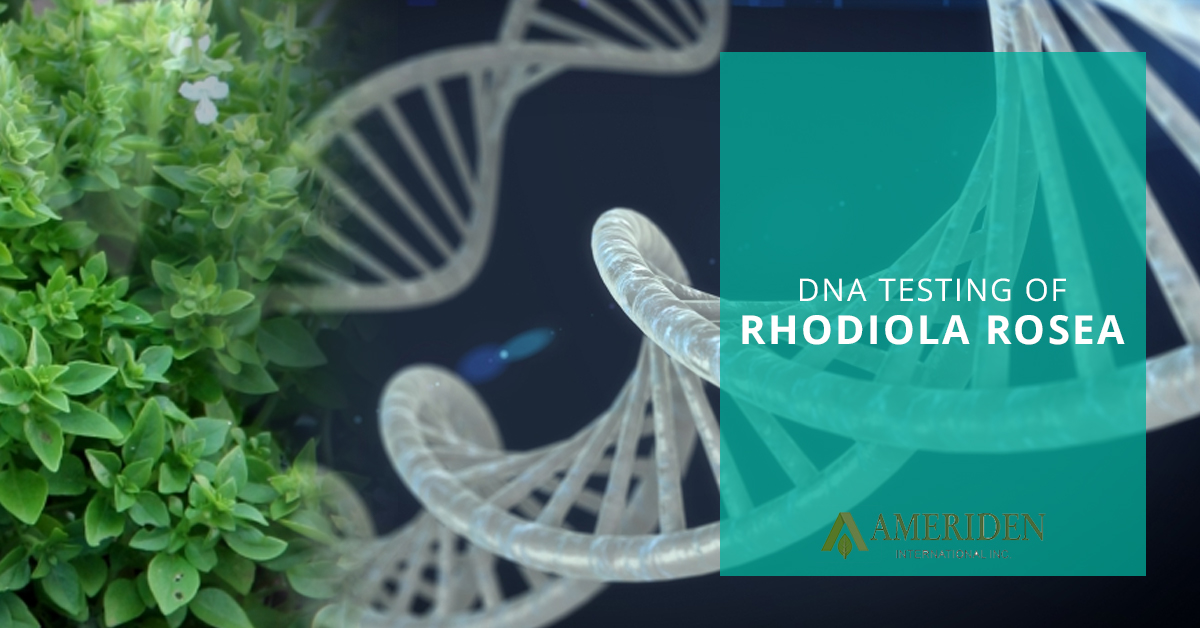DNA Testing of Rhodiola Rosea
Posted by Ameriden International on 23rd Jun 2017

DNA Testing of Rhodiola Rosea
In 2015, the New York Attorney General claimed that some dietary supplements that were collected and DNA-tested did not contain the ingredients claimed on their labels. The natural product and supplement industry was upset because DNA testing is not a recommended test to determine plant ID, potency or safety at the supplement level. While DNA testing is not the proper method for most finished products, it is applicable at the raw product stage to determine species.
At Ameriden International, we want to be proactive in this endeavor and provide our online health supplement customers the most up-to-date information available. As a complementary test to our already established pre and post-product testing regime, we have our rhodiola rosea DNA tested.
DNA Can Help Establish the Chemotype.
Just as in humans, each plant has a specific chemotype. The chemotype is a chemically distinct entity in a plant or microorganism of the species which has traditionally been defined by its profile in natural products by its genetic constitution or DNA sequence. However, with the development of DNA sequencing methods and the discovery of the polymerase chain reaction (PCR) for DNA amplification, DNA sequence analysis has been illuminated. The genotypes identified by PCR amplification now suffice to predict the species of plants in a greater depth.
With PCR amplification and subsequent restriction analysis of the rhodiola ribosomal region spacers (ITS1 and ITS2) and the 5.8S rRNA gene, identification of Rhodiola rosea, belonging to the genus Rhodiola, is certain. This methodology has previously been used for the identification of other species of this genus, but in this present testing the application has been applied to the identification and characterization of the species rhodiola rosea. Rhodiola rosea is a genus of Rhodiola with a special interest in clinical and biotechnology.
Among the species of the genus Rhodiola, variability was observed both in the length of the amplified region (ranging between 380 and 600 bp) and in restriction patterns, allowing for unequivocal identification of the species level (Rhodiola), which may also include other groups of species including R. Crenulata, R. sacchalinensis, C. kirilowii, C. coccinea, C. gelida, C. heterodonta, C. alterna, C. fastigita and C. quadifida. But because these other groups do not contain “rosavins” (rosavin, rosin, rosaridin, rosarin, rosaridol), they were not included in this study.
To determine the other species would require sequencing of the D1/D2 domain of the 26S rRNA gene or the 5.8S-ITS region for their specific length of the amplified region and proper subspecies differentiation.
The main purpose of this testing was to determine the ID for the R. “rosea” subspecies as well as contribute more information to the global plant databases. Also this testing helps to facilitate fast reliable identification of a species in the future.
The genus Rhodiola contains over 70 species, which are usually found in high, cold mountain regions of the Northern Hemisphere. The species is mainly associated with the Crassulacea family and sporadically reported in the sedum family. The identification of the Rhodiola rosea species still largely relies on phenotype-based methods. There is a need for a molecular diagnostic approach that would allow groups to reliably discriminate between the different Rhodiola’s. The aim of this test was to apply sequence analysis of its partial 28S rRNA gene for species identification of the Rhodiola rosea clinical isolates.
Although the method employed did reveal some genetic polymorphism among Rhodiola isolates tested, to determine the “rosea” variety, it was not enough for complete species delineation. For this to be achieved, other genetic loci, within and beyond the rDNA operon, need to be investigated. A polymorphic genetic map would allow the different strains to be distinguished genetically. The more detailed the linkage map the better the mapping resolution will become.
In addition to genetic taxonomy, DNA testing and other classical morphological and non-morphological methods such as phytochemical taxonomy can also provide supplementary information in species identification for the future.
In summary: The DNA testing undertaken by ABC Testing shows that the Rhodiola sample to be that of “Rhodiola rosea” with its sequence producing significant alignment and a query length at 387. This differentiates it from any other species variety based on its ribosomal region spacers (ITS1 and ITS2) and the 5.8S rRNA gene. This information also improves all online databases available by unveiling the distinct numerical value.
The chemotaxonomic classification of Rhodiola plants and its correlation with morphological characteristics and genetic taxonomy
http://www.ncbi.nlm.nih.gov/pmc/articles/PMC371870...
The Phylogenetic Potential of Entire 26S rDNA Sequences in Plants
http://mbe.oxfordjournals.org/content/15/3/251.ful...
Rhodiola DNA Bar Coding
http://www.ncbi.nlm.nih.gov/pmc/articles/PMC436118...
DNA Based Tests for Rhodiola


